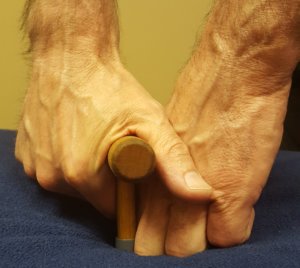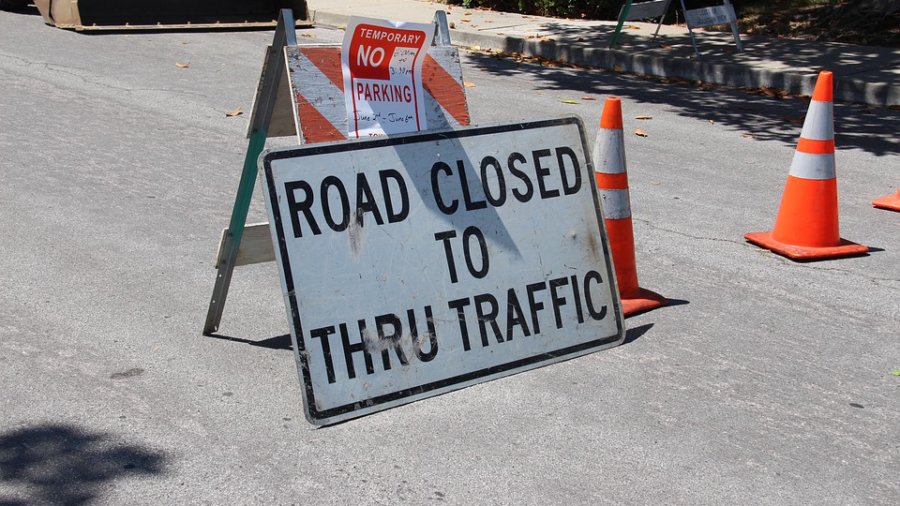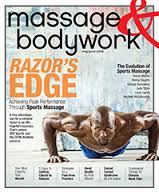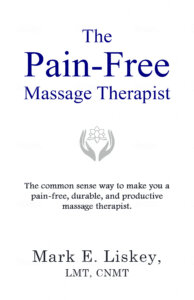What makes a massage therapist durable? It’s whether or not the MT makes massage adjustments.
Wait. What about the things you bring with you into massage, like old injuries, dysfunctions, etc., that affect how you work?
Yep, they’re important.
And how about: Do you do massage in way that is hard on your body?
Absolutely. Can’t overlook that.
But most of us get these points.
What’s less obvious is: Do you make massage adjustments?
What are Massage Adjustments?
When I say massage adjustment I’m talking about a change you make regarding how you approach or do massage that keeps you out of pain.
An adjustment can be part of a plan.
Or it could be something you do right before the massage.
Or it could be something you do on the fly (while you’re doing the massage).
Let’s get specific.
1. Planned adjustment: This is an adjustment that is scheduled in advance.
For example, let’s say that you usually use your fists for your primary glide stroke, but recently you strained your left wrist working out. So for the next week you decide that you’re going to use your forearms instead of your fists as your primary glide stroke.
2. Before the massage adjustment is something you do before the massage to avoid potential pain.
Joe, a big person, wants deep pressure massage, so you lower your table more than normal so that you have more leaning leverage which makes the work easier on your upper-body.
3. During the massage adjustment happens on the fly.
Your right thumb is bothering you as you’re pressing into a trigger point in a calf muscle, so you switch to a T-bar or you switch to your left thumb supported by your right fist.

Keys for Making a Massage Adjustment
To get good at making massage adjustments you need to:
1. Pay attention.
Basically, you’ll need to tune into your body while you’re doing the massage. The goal is not become hyper-vigilant. The goal is to become aware of when you’re overstressing areas of your body. Once you become aware, you’ll need to…
2. Connect the dots.
In other words, you’ll need to recognize patterns that lead to pain. For example, let’s say that you mainly press with your right hand. After a long day of pressing with your right hand, you notice that the right side of your neck bothers you. Once you make the connection, you’ll need to…
3. Experiment with making massage adjustments.
Sticking with the example of neck pain, you could experiment with using your other hand to balance out the work load.
Make Massage Adjustments Work for You
This is how making adjustments might look like in real life.
You did a day’s work of detailed work and your hands are aching. So for your last massage, you make an on the fly adjustment by using massage tools to give your fingers a break.
The next day you work outside in the yard, which gets your hands fired up again. So you decide to use massage tools as much as you can for the rest of the week (planned adjustment).
As the week goes on you notice that some deep pressure clients are still hard on your hands even with massage tools. So you decide to lower the table more than normal before each deep pressure client (before the massage adjustment). This will allow you to use your body weight to your advantage.
Adjustments For The Rest of Your Massage Life
Sounds like a lot of work, Mark.
A little in the beginning, but after you develop the habit of making adjustments, it’s a cake walk.
Here’s how to develop the habit of making massage adjustments: (1) Note when pain occurs when you’re working, (2) make a connection to what may be causing it, and (3) then make an adjustment.
The adjustment can be part of a plan or it can happen right before the massage or during the massage.
Boom.
This article will help you with more ways to adapt: How to Eliminate Pain When Massaging: Adaptation.
Can you be durable and massage pain-free for the rest of your massage career?
Here’s the online, home-study (3 CEU) massage class that I’ve designed to make sure that you can: How to Deliver Deep Pressure Without Hurting Yourself.






